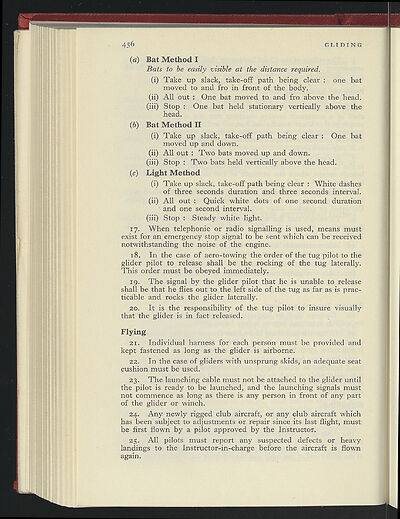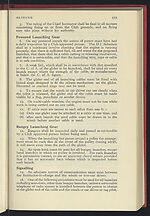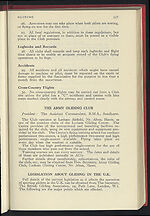1959-60
(524)
Download files
Complete book:
Individual page:
Thumbnail gallery: Grid view | List view

I
E
IH
45
6
GLIDING
(a)
Bat Method
I
Bats to be easily visible at the distance required.
(i) Take up slack, take-off path being clear : one bat
moved to and fro in front of the body.
(ii) All out : One bat. moved to and fro above the head.
(iii) Stop : One bat held stationary vertically above the
head.
(b)
Bat Method
II
(i) Take up slack, take-off path being clear : One bat
moved up and down.
(ii) All out : Two bats moved up and down.
(iii) Stop : Two bats held vertically above the head.
(c)
Light Method
(i) Take up slack, take-off path being clear : White dashes
of three seconds duration and three seconds interval.
(ii) All out : Quick white dots of one second duration
and one second interval.
(iii) Stop : Steady white light.
z7. When telephonic or radio signalling is used, means must
exist for an emergency stop signal to be sent which can be received
notwithstanding the noise of the engine.
18.
In the case of aero-towing the order of the tug pilot to the
glider pilot to release shall be the rocking of the tug laterally.
This order must be obeyed immediately.
z9. The signal by the glider pilot that he is unable to release
shall be that he flies out to the left side of the tug as far as is prac-
ticable and rocks the glider laterally.
20.
It is the responsibility of the tug pilot to insure visually
that the glider is in fact released.
Flying
2I.
Individual harness for each person must be provided and
kept fastened as long as the glider is airborne.
22.
In the case of gliders with unsprung skids, an adequate seat
cushion must be used.
23.
The launching cable must not be attached to the glider until
the pilot is ready to be launched, and the launching signals must
not commence as long as there is any person in front of any part
of the glider or winch.
24.
Any newly rigged club aircraft, or any club aircraft which
has been subject to adjustments or repair since its last flight, must
be first flown by a pilot approved by the Instructor.
25.
All pilots must report any suspected defects or heavy
landings to the Instructor-in-charge before the aircraft is flown
again.
E
IH
45
6
GLIDING
(a)
Bat Method
I
Bats to be easily visible at the distance required.
(i) Take up slack, take-off path being clear : one bat
moved to and fro in front of the body.
(ii) All out : One bat. moved to and fro above the head.
(iii) Stop : One bat held stationary vertically above the
head.
(b)
Bat Method
II
(i) Take up slack, take-off path being clear : One bat
moved up and down.
(ii) All out : Two bats moved up and down.
(iii) Stop : Two bats held vertically above the head.
(c)
Light Method
(i) Take up slack, take-off path being clear : White dashes
of three seconds duration and three seconds interval.
(ii) All out : Quick white dots of one second duration
and one second interval.
(iii) Stop : Steady white light.
z7. When telephonic or radio signalling is used, means must
exist for an emergency stop signal to be sent which can be received
notwithstanding the noise of the engine.
18.
In the case of aero-towing the order of the tug pilot to the
glider pilot to release shall be the rocking of the tug laterally.
This order must be obeyed immediately.
z9. The signal by the glider pilot that he is unable to release
shall be that he flies out to the left side of the tug as far as is prac-
ticable and rocks the glider laterally.
20.
It is the responsibility of the tug pilot to insure visually
that the glider is in fact released.
Flying
2I.
Individual harness for each person must be provided and
kept fastened as long as the glider is airborne.
22.
In the case of gliders with unsprung skids, an adequate seat
cushion must be used.
23.
The launching cable must not be attached to the glider until
the pilot is ready to be launched, and the launching signals must
not commence as long as there is any person in front of any part
of the glider or winch.
24.
Any newly rigged club aircraft, or any club aircraft which
has been subject to adjustments or repair since its last flight, must
be first flown by a pilot approved by the Instructor.
25.
All pilots must report any suspected defects or heavy
landings to the Instructor-in-charge before the aircraft is flown
again.
Set display mode to:
![]() Universal Viewer |
Universal Viewer | ![]() Mirador |
Large image | Transcription
Mirador |
Large image | Transcription
| Games and sports in the army > 1959-60 > (524) |
|---|
| Permanent URL | https://digital.nls.uk/248869850 |
|---|
| Description | 'Games and Sports in the Army' was an annual publication produced by the British War Office between the 1930s and 1960s. This included the Second World War. It outlines the rules and regulations for games and sports played by members of the armed forces. It features names and photographs of team members, and examples of contemporary advertising. |
|---|---|
| Shelfmark | GWB.52 |

